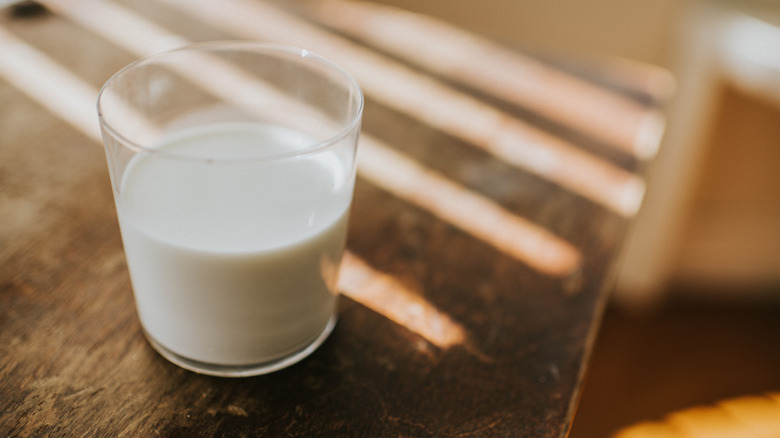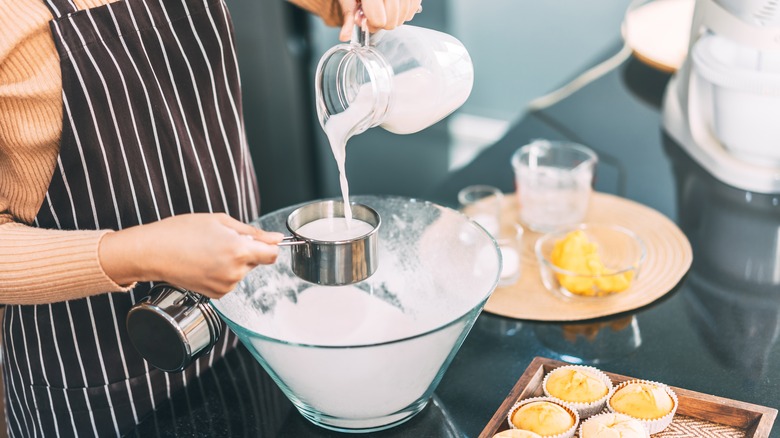What Happens If You Drink Spoiled Milk?
There's nothing quite like pouring a glass of milk, taking a sip, and coming to the horrifying realization that it's spoiled. Milk spoils due to bacteria — such as psychrotrophic bacteria, which grows in cold environments. Bacteria can even grow in pasteurized milk if it is introduced by you drinking directly from the carton, for example. As the bacteria multiply, they cause the texture, taste, and quality of the milk to degrade, resulting in spoilage.
While the thought of consuming spoiled milk might be enough to make you sick, most people, thankfully, won't experience any negative side effects after drinking only a few sips. Many bacteria in milk are harmless in small quantities, but dangerous types, such as E. coli, can still be present. In a 2011 study from Mazandaran University of Medical Sciences, E. coli was found in 9% out of 100 pasteurized milk samples. In 2022, in South Yorkshire, England, an E. coli outbreak connected to a milk pasteurization failure was reported.
As can be expected, raw milk has an even higher chance of containing this harmful pathogen and others, including salmonella and listeria. These can cause food poisoning, which presents as diarrhea, vomiting, nausea, and stomach cramping. These symptoms usually resolve on their own within 12 to 24 hours, but see a doctor if they last longer than that.
How you can tell if your milk is spoiled
Milk is usually safe to consume several days past its best-by date, as these dates are more for quality than food safety. However, it's still a good idea to double-check so you don't accidentally chug down some chunky milk. The sniff test is one of the most common methods of checking for spoilage. If your milk has a sour or otherwise funky smell, it's probably on its way out. Other signs include a sour taste and a yellowish color. Eventually, spoiled milk will begin congealing and becoming lumpy.
If you want your milk to last as long as possible, keep it below 40 degrees Fahrenheit. However, because fridge temperatures can fluctuate, milk is best stored towards the back, where it won't be as affected by the door opening. You'll also want to avoid leaving your milk out longer than necessary when using it. Alternatively, milk can be frozen in an airtight container, but this will change its texture, so it may be better to cook with than to drink. Skim milk freezes better than whole milk, as the latter tends to separate when thawed.
You can use slightly spoiled milk to bake with
Now, baking with sour milk might seem like a bad idea, but it's actually a trick that many chefs use around the world. However, we're talking about using slightly soured milk, not the kind that's gone full-on chunky. If your milk smells terrible, has a yellow hue, or is lumpy, you should totally toss it out. That said, sour milk adds a nice tang to many dishes thanks to its increased acidity which is caused by lactose transforming into lactic acidas it spoils. This makes it a great addition to many breads, where it acts as a leavening agent, and to other baked goods like scones and biscuits.
Sour milk can also be used in soups and stews as a thickener, used to make salad dressings like ranch and blue cheese, or turned into homemade cheese. While fresh milk can also be used to make cheese by curdling it with vinegar or lemon juice, sour milk jumpstarts the process and makes it quicker. Moreover, it can be used as a substitute for buttermilk, such as in the recipe for buttermilk pancakes.


